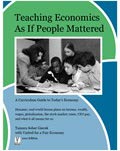|
Musical chairs in High School? Absolutely! This is a terrific lesson plan from
Teaching Economics As If People Mattered where the students act out the
distribution of wealth in the United States. What is wealth and who owns how
much of it? What are assets and debts? What changes have families seen in their
economic condition between 1976 and today? Those are just a few of the questions
that will be covered in Lesson 10 which includes a very popular activity known
as the "Ten Chairs."
The following information will help you, the teacher, prepare to have a lively,
engaging, and effective hour of learning with your students. This page includes
an animated presentation which introduces all the concepts taught in
the lesson and shows you, step-by-step, how to prepare for and teach the lesson.
Print out the lesson plan and charts and then launch the animated overview (below).
Learning Objectives
This lesson, which takes approximately one classroom hour (55 minutes) has
the following learning objectives:
- Define the concepts of wealth and assets
- Compare wealth and income
- Apply an understanding of the definition of wealth by providing examples
of wealth for different income groups
- Dramatize the shift in wealth from 1976 to 2004
- Links to recent articles below allow you to have more recent information
Concepts and Key Terms
The following concepts and key terms are covered in this lesson:
- Wealth
- Wealth compared to income
- Current concentration of wealth in the United States
- Shift in concentration of wealth in the United States from 1976 - 2004
- Links to recent articles below allow you to have more recent information
Download Lesson Plan, Charts, and Student Placard
This file requires the Adobe Acrobat reader. It is available for free from
Adobe
Systems.
Overview Presentation
Before viewing this presentation, you will need to download and print out the
lesson plan, charts, and student placard (above) and you also need to have two
pieces of writing paper and a pen or pencil. The presentation includes a voice-over
so please turn your computer speakers on. The presentation provides an overview
of the concepts covered in the Ten Chairs as well as step by step instructions
for carrying out the lesson plan in your classroom. The entire multimedia presentation
takes approximately 15 minutes, but if you are in a hurry, there's
a button you can click that will take you directly to the demonstration of the
ten chairs exercise which only takes a few short minutes (and is a lot of fun
to watch).

Click
here to view the presentation
Articles and Other Web Resources
While the lesson plan provides everything you need to carry out the lesson
in your classroom, you may want to familiarize yourself with recent articles
and web resources concerning the issues raised in this lesson. We have selected
several for you and have linked to them below. We encourage you to explore other
resources and ask that you let us know of other links we should add to this
page.
National Standards Mapping
This specific contents and discussion topics provided for in this lesson map
into the following National Council on Economics Education (NCEE)
standards:
- Standard 11 (the role of money)
- Standard 13 (the role of resources in determining income)
- Standard 16 (the role of government)
- Standard 20 (monetary and fiscal policy)
 |
|
United for A Fair Economy (UFE) and Tamara Giecek created a High School
curriculum based on many of the popular seminars and programs UFE delivers
to adults across the United States. The entire curriculum is available
in book form through the Reach
And Teach Store.
Reach And Teach, UFE, and Tamara Giecek are working together to update
the curriculum and create an on-line version of all the lessons similar
to the lesson we have provided on this page. We are currently working
with various foundations and private donors to raise the money needed
to bring this wonderful educational opportunity to the web. Teachers across
America will be able to use the overview presentations to prepare to teach
and then download the lesson plans, share ideas with other teachers about
new ways to teach the lessons, and recommend additional lesson plans to
the Teaching Economics team.
Would you like to help make this a reality? If so, click
here to make a donation to United for A Fair Economy and click the
Ten Chairs box to designate your donation to helping us get the rest of
the Teaching Economics lessons on the web!
|
| |
|
|
 |
|
And..... while we're on the subject of people really mattering......... Reach And Teach would also like to suggest you consider this incredible math book by Edward Zaccaro. Students typically are not given the opportunity to see the wondrous side of mathematics because it is often taught as all scales and no music. Help your students:
- Discover the power of mathematics as the danger of short-term loans is exposed in a dramatic fashion
- Investigate math mistakes in news media and their potential consequences
- Watch as mathematics shows the futility of depending on corn-based ethanol to lower our dependence on oil imports
- Learn the surprising answer to how much money a hybrid car will save its owner because of reduced gasoline usage
- Discover what mathematics tells us about teenage drivers.
These and other fascinating math investigations will allow students to see the power of mathematics as it cuts through deception and flawed thinking to reveal the truth. Click here to check out this book! |
|



